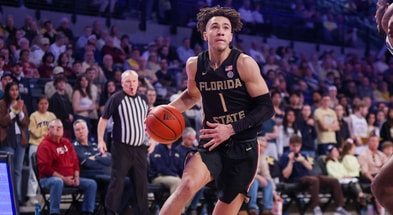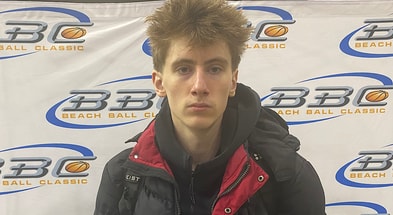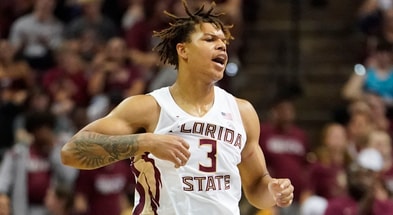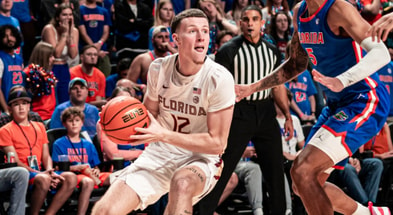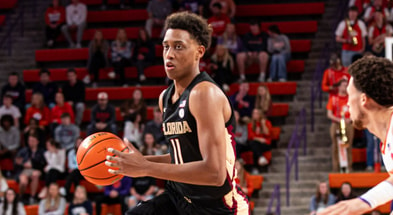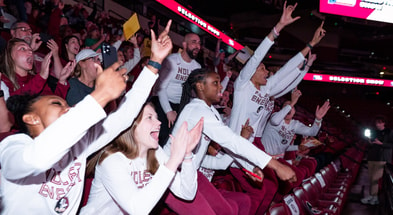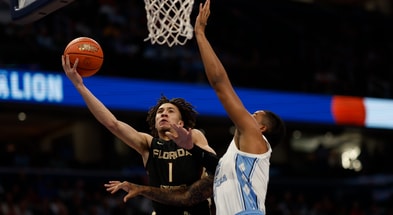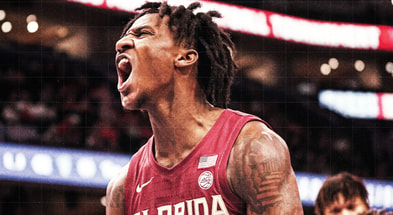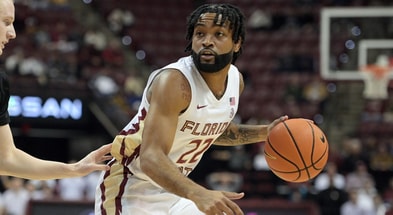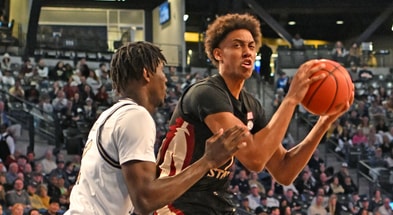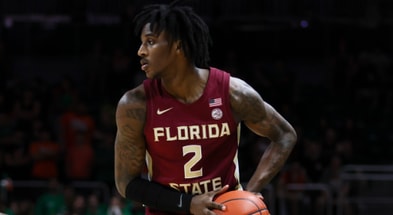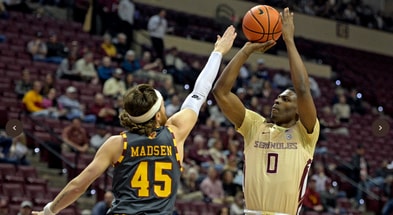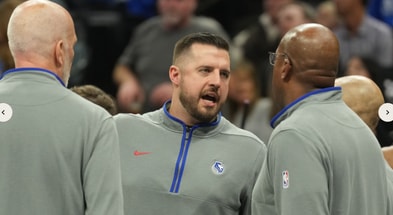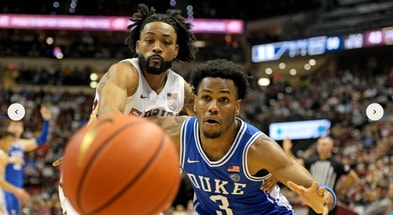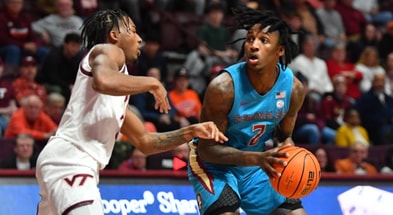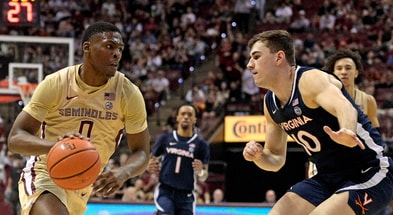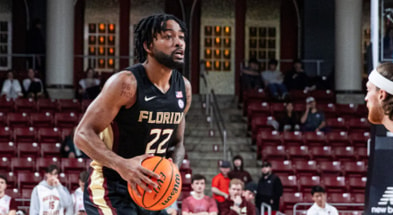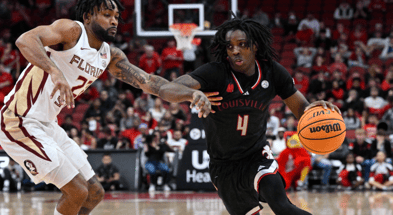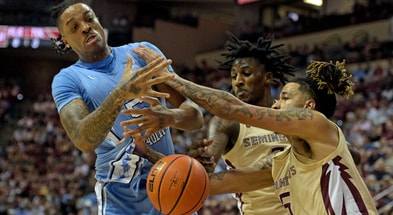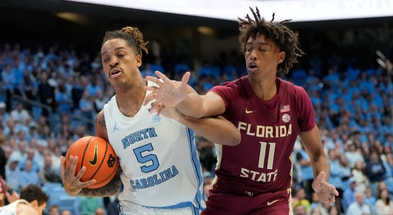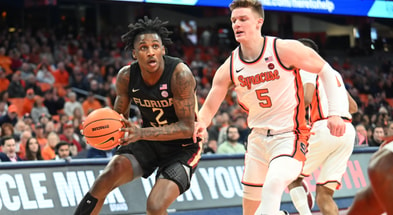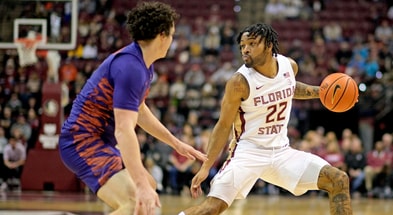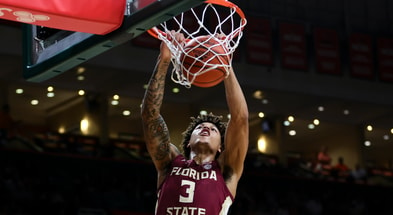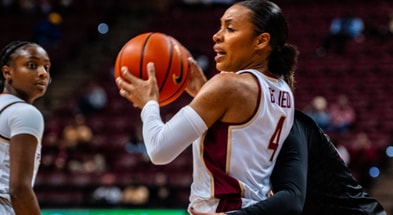After dismal season, Leonard Hamilton already working on next Florida State revival
It’s late Friday morning, and Leonard Hamilton would rather be preparing Florida State for another game in the ACC Tournament. Or waiting to learn his team’s destination and initial opponent in the Big Dance.
Instead, he has been working the phones since about 7 a.m., surveying the college basketball landscape. Checking in with contacts, getting a feel for which impact players are expected to be entering the transfer portal this offseason, and figuring out which of his own players will definitely be returning in 2023-24.
It’s a process Hamilton likely never envisioned when his Florida State men’s basketball team emerged as a national power during his second decade as head coach.
Three years ago, Florida State was a trendy pick to win the 2020 national championship before a worldwide pandemic shut down the postseason. The year before that, the Seminoles set a school record with 29 victories. The year before that, they advanced to the Elite Eight of the NCAA Tournament for only the third time in school history.
From 2016 through 2021, Hamilton’s program became a model for other college coaches to emulate.
The Seminoles found a way to seamlessly blend elite one-and-done talents with home-grown veterans who developed into stars and leaders by their junior and senior seasons. They coupled a wide-open offensive style with Hamilton’s trademark “Junkyard Dog Defense” to create a fast-paced, entertaining and often dominant style of play. And they were filling NBA rosters with first- and second-round draft picks.
Simultaneously, Hamilton kept doing what he has always said was his greatest calling — graduating nearly every single one of his players and producing high-character alumni who would enjoy great success as players, coaches, executives, fathers and husbands.
Indeed, Florida State Men’s Basketball had become a model college basketball program in every conceivable way.
But that’s not what Hamilton’s Seminoles look like on this morning, just three years later.
Not in the win-loss column anyway.
Not even close.
‘The buck stops with me’
As he leans forward at his desk in a spacious corner office of Florida State’s Basketball Training Center, Leonard Hamilton logs onto his computer and pulls up a folder with video cut-ups from a Florida State home game against Louisville. The date was Feb. 24, 2020, and the Cardinals came into the Tucker Center with a half-game lead over FSU in the ACC standings.
Both teams were ranked in the top 10 of the coaches’ poll; Florida State was No. 6 and Louisville was No. 10.
Hamilton doesn’t explain why he has selected this particular game footage, but the message becomes crystal clear within seconds. He wants to show a visitor what his teams are supposed to look like on offense and defense. He intends to illustrate what his players did so well during their brilliant five-year run so that there’s a better understanding of why his most recent squad — the 2022-23 Seminoles — came up so far short of expectations.
That’s not to say Hamilton blames the current players for this dismal campaign — a year that ended with a 9-23 record and established a new Florida State mark for most losses in a season. He has said repeatedly in interviews and press conferences that he takes full responsibility.
He is the one who didn’t believe talented-but-raw 7-footer John Butler would declare for the NBA Draft after his freshman season. He is the one who assumed that one or both of his most experienced players, guard Anthony Polite and forward Malik Osborne, would return for another year. And he is the one who signed six high school seniors in a year when many other college coaches were loading up with college transfers.
“Obviously, the buck stops with me,” Hamilton said two weeks ago. “I feel fully responsible.”
Now, he has to do something about it. And no one knows that better than Hamilton.
The transfer portal for college basketball opened on Monday for a 60-day window, and Florida State is expected to be a very active participant. While Hamilton is always reluctant to discuss the comings and goings of his roster, often reminding reporters to not, “try to count my scholarships,” he has acknowledged publicly that he will be looking to add several experienced players this offseason.
That will be a new approach for the 74-year-old head coach.
Even in recent years, when Florida State was getting its share of one-and-done talents like Scottie Barnes, Jonathan Isaac, Patrick Williams and Malik Beasley, the backbone of his program has always been player development. Finding under-the-radar athletes and turning them into elite college players.
Then keeping those self-made veterans in his program for three, four or five years, and leaning on them to help teach their younger teammates the finer points of his systems. It was the very fabric of his program’s culture.
But after one of the most disappointing and difficult years of his five decades of college coaching, Hamilton understands that time is not on his side. He simply can’t wait for the youngest team of his 21-year tenure at Florida State to mature and develop.
Not when other programs throughout the ACC are stocking up on experienced transfers.
“I just didn’t get the memo,” Hamilton said recently. “I had to learn the hard way. But I got it now.”
How did Florida State get here?
It’s fair to say that Hamilton and his Florida State coaching staff never saw this coming.
Expectations were high inside the program last summer, even after a few somewhat surprising departures. Yes, they had lost a half-dozen key players from the 2021-22 team — a squad that at one point led the ACC with a 6-2 record before experiencing a rash of injuries and then free-falling out of postseason contention.
But there was excitement about the growth of young players like Matthew Cleveland, Jalen Warley and Naheem McLeod. And key transfers Jaylan Gainey and Darin Green Jr. were coming on board, along with several talented freshmen. If the the Seminoles could also get more from returning veterans Caleb Mills and Cam’Ron Fletcher, there was confidence they could push their way back into the NCAA Tournament after a one-year absence.
It’s why Florida State was picked to finish fifth in the ACC during the preseason.
Unfortunately for the Seminoles, almost none of that materialized.
- Gainey, a smart and physical 6-foot-10 shot-blocker and rebounder, who was a two-time Ivy League Defensive Player of the Year, went down with a season-ending knee injury during preseason.
- Baba Miller, a highly touted freshman from Spain, was suspended for the first 16 games of the season by the NCAA and also dealt with nagging injuries.
- Freshman point guard Chandler Jackson, who was going to be counted on heavily following Polite’s departure, broke his thumb during the preseason and missed well over a month of practice.
- Fletcher, a versatile junior who could start at several positions, including center, went down with a season-ending knee injury less than a month into the season.
- Two more freshmen, forward De’Ante Green (ACL) and guard Jeremiah Bembry (back), arrived at Florida State with pre-existing injuries.
And of the returning players, Cleveland was really the only one to show substantial improvement once the games started.
McLeod seemed to regress and lose his confidence, Warley made modest strides but was inconsistent, and Mills was essentially the same player he was the year before. Darin Green Jr., the UCF transfer, had some nice moments and proved to be an effective 3-point shooter, but he was one of several players who struggled on the defensive end and contributed little in terms of rebounding.
And every major contributor on the roster appeared to fade down the stretch, faltering under the weight of extended minutes in an injury-shortened rotation. During the final weeks of the season, at least two of Florida State’s top players seldom practiced between games because their bodies were so fatigued.
Add all of those elements together, and you get a 9-23 record and 12th-place finish in the ACC — the worst of Hamilton’s tenure.
What it’s supposed to look like
Leonard Hamilton’s voice rises and he gets visibly excited when stopping, starting and rewinding the video from that Florida State game against Louisville three years ago.
He looks like a symphony conductor appreciating a perfectly played concerto. Or a scientist elated about a breakthrough experiment.
He starts by pointing out the way Trent Forrest is pressuring the Cardinals’ point guard every step up the floor. “Nobody picks up 94 feet like we do,” Hamilton says with a mixture of pride and defiance.
The point of this ball-pressure, the head coach explains, is not to force a turnover. It’s merely the first prong in a multi-faceted approach, with the intention of wearing down the Seminoles’ opponents.
Instead of being permitted to walk the ball up the court and conserve energy, Louisville’s ball-handlers have to stay low to the ground, be strong with their dribble and frequently change directions just to get across half-court and try to initiate their offense. Then once they accomplish that, a whole new set of issues are presented.
Hamilton pauses the video to show guard Devin Vassell obstructing a passing lane with his outstretched arm. And Malik Osborne “fronting” the Cardinals’ post player to prevent Louisville from getting the ball down near the basket. Meanwhile, M.J. Walker is crowding another Louisville guard on the perimeter to make sure if he does receive the ball, he will be far beyond the 3-point line, which forces the Cardinals to eat up more precious seconds off the shot clock.
And any time a Louisville player does catch a pass beyond the arc, a Florida State defender is there on the catch — with his hands held high to prevent passes into the paint and to contest long shot attempts. The Cardinals’ ball-screens are also completely ineffective, since the Seminoles will switch all five defenders at any moment.
Possession after possession, Louisville can seemingly never get a clean look at the basket. The Cards repeatedly rush shots just before the 30-second clock expires.
“I’ve watched so many games, and nobody runs their offense against Florida State,” then-Louisville coach Chris Mack said after that game. “And it’s a credit to how they play.”
Mack’s Cardinals entered that late-February contest sitting atop the ACC standings, and they finished the year with a 15-5 league record. Of their five losses, two came to Florida State; they went 15-3 vs. the rest of the conference. That Louisville team also went 17-1 at home, with the sole loss coming to Hamilton’s Seminoles — by 13 points.
It marked the first time Florida State had swept Louisville home and away in more than 40 years.
After the contest in Tallahassee — a game that Louisville actually led at halftime before the Seminoles dominated the second half and ended the game with a 39-14 run — Mack was asked how talented the Seminoles were.
“I think the most impressive thing isn’t their talent level,” he said. “It’s how hard they play. I said that to Leonard before the game. I have such a respect for how hard he gets his kids to play.”
Assessing the problems
The easiest two assumptions to make about Florida State’s poor performance in 2022-23 are that the roster isn’t as talented as it was from 2016-21, and that Hamilton isn’t the same head coach as he enters his mid-70s.
We’ll address the latter statement in a moment.
While it’s fair to say this Seminoles squad didn’t have a point guard like Trent Forrest, a wing like Terance Mann or a forward like Patrick Williams, anyone who believes that Hamilton’s program was built on star players has not really been paying attention.
Going back to his days at Miami in the old Big East and throughout his 20-plus years at Florida State in the ACC, Hamilton has always known his top players would not be good enough to consistently beat the elite programs in their conference. He would try to recruit and develop a starting five that could compete with Georgetown and UConn in the 1990s and then Duke and North Carolina in the 2000s and beyond, but his best weapons would be his teams’ depth, toughness, length and athleticism.
“I’m not going to beat them with my 1-through-5,” Hamilton would often say. “I’ve got to beat them with my 6-through-11.”
And that’s just what he did during all of his great runs, including those recent five seasons from 2016-21.
Let’s take that February 2020 Louisville game as an example.
Nine Florida State players saw more than 10 minutes of action that day, while only seven did so for the Cardinals. One Louisville starter played 38 minutes and another played 34. No Seminole played more than 30.
Now think back to how Florida State competed in that game. Pressuring the ball all 94 feet up the court. Contesting every pass. Fronting the post. Overplaying on the perimeter to force catches far from the basket. Switching one through five. And constantly rotating fresh bodies off the bench.
Is it any wonder why the Seminoles closed that game with a 39-14 run?
It’s the same reason they were able to win 25 consecutive home games in ACC play — a mark that ranks second all-time in conference history. How they set an NCAA record with 13 consecutive overtime victories.
Time and again, Hamilton’s Seminoles rocked their opponents with relentless effort and execution, and then sent waves of bodies at them to ultimately break their will.
This current Florida State men’s basketball team was unable to do any of that consistently.
Because they had no veterans with more than two years’ experience in the system, the team lacked precision with its offensive and defensive principles. Late in the regular season, the coaches were still teaching basic fundamentals that had been ingrained in years’ past.
And the team’s lack of depth forced top players to log extensive minutes night in and night out. Green averaged 34.1 minutes, and Cleveland averaged 33.6. Warley and Mills averaged nearly 30, as did Fletcher before he was hurt.
Using Florida State’s 2019-20 season once again for comparison, Trent Forrest played an average of 30.8 minutes and Devin Vassell averaged 28.8. No one else averaged more than 25 minutes, and 11 different players averaged at least nine.
So is the Seminoles’ current problem really a lack of talent? It could be. But the deficiencies in experience and depth appear to be at least major aggravating factors.
Even when Florida State’s players knew what they were supposed to be doing this season, they sometimes were so fatigued that they couldn’t accomplish those tasks correctly.
Consider these statistics: In 2022-23, Florida State’s opponents averaged 76.2 points while shooting 45.4 percent from the floor and 37.6 percent from 3-point range. In 2019-20, FSU foes averaged 65.7 points while shooting 40.6 percent from the floor and 31.4 percent from 3.
What does the future hold?
No matter what happens during the 2023-24 season or beyond, Leonard Hamilton’s legacy at Florida State is secure.
He has won more games than any other men’s basketball coach in school history, and he ranks fifth all-time for ACC career victories. The only coaches above him are Mike Krzyzewski, Dean Smith, Roy Williams and Gary Williams.
Hamilton also has led Florida State to the only ACC regular-season (2020) and tournament (2012) championships in school history.
He could walk away today and go down as one of the greatest college basketball coaches of all time, for his work at Florida State, Miami and Oklahoma State, and as an assistant at Kentucky and Austin Peay before that.
But clearly, that is not his intention.
He has two more years on his most recent contract extension, and he wants to get Florida State back on track.
“This is a speed bump, it’s not a train wreck,” Hamilton said after a late-season loss to North Carolina. “We’ll get back to where we’re supposed to be.”
Can he turn his program back around? Can he acquire three or four high-quality and experienced transfers to go with the key pieces he has returning and highly touted freshman Taylor Bol Bowen? Can he pull off a one-year resurgence thanks to transfers the way Pitt, N.C. State and others have done this season?
There is no word yet on what leading scorer and rebounder Matthew Cleveland plans to do. He at least contemplated a jump to the NBA after his freshman season, and his statistics were better this year across the board.
But even if Cleveland leaves, the Seminoles should be able to bring back every other player they desire. And they also will see the return of Gainey, the 6-10 former Brown star who missed the entire year, and Fletcher, who went down in December.
Whatever the roster ultimately looks like, one can rest assured it will feature at least 10 or 11 capable bodies who will give Hamilton the type of depth his system requires. So he can get back to wearing down FSU’s opponents. And so the Seminoles can return to competing at full-speed for the entire 40 minutes.
There undoubtedly are some in the Florida State fan base who question whether Hamilton can rekindle the magic his program enjoyed from 2016-21.
They point to the losses of key assistants Dennis Gates in 2019 and Charlton Young in 2022 as substantial blows. They question whether FSU has the resources from an NIL standpoint to attract the types of players needed to compete at the highest levels. They wonder if Hamilton still has the fire and energy to reinvent himself one more time.
None of us will know the definitive answers to those questions for several months, or maybe until this time next year.
But it’s worth remembering that Leonard Hamilton has been doubted at literally every stage of his life and career. When he became the first black player at his junior college and again at Tennessee-Martin. When he became the first black assistant coach at the University of Kentucky. When he took over a struggling Miami Hurricanes program, and then did the same thing a decade later at Florida State.
And he has produced one success after another after another.
It’s also worth remembering that it was less than a decade ago that Hamilton completely transformed his offensive approach. In an effort to attract elite recruits and produce better results, the Seminoles began spreading the floor and embracing “positionless” basketball — meaning 7-footers would have as much freedom to play on the perimeter as smaller guards.
It’s the style of play that has become pervasive in the NBA. And that switch, which Hamilton signed off on in his mid- to late-60s, was crucial to the Seminoles landing elite prospects like Jonathan Isaac, Scottie Barnes and Patrick Williams — all three of whom went on to be top-six picks in the NBA Draft.
If Hamilton is going to resurrect his Florida State program one more time, he’ll have to prove he can adapt again. He’ll have to become much more proficient in the portal, and only time will tell if he will be successful.
The doubters have already started lining up to bet against him, like they always have.
If they are proven right this time, it will be quite the accomplishment.
They have never gotten it right before.
Contact Warchant managing editor Ira Schoffel at [email protected] and follow @IraSchoffel on Twitter.
***Talk about this story with other die-hard FSU Basketball fans on our Seminole Hoops Message Board.***
